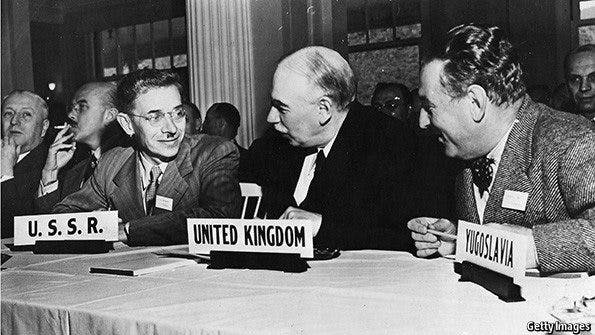The History of Bretton Woods
Set in place by 44 nations at the end of World War II, the Bretton Woods economics system was unprecedented at the time and warranted new centralized mechanisms of governance to ensure its continued functioning.

- Under the Bretton Woods agreement, the US dollar’s exchange rate was fixed to gold at $35 an ounce while all other currencies’ exchange rates were set against the US dollar.
- It was thought that the currency system could be managed with much more flexibility while also retaining an objective root in gold through the US dollar.
In 1944, as World War II was drawing to a close, the Allies urgently needed financial stability. Not only did they face currency wars, trade disruptions and financial panics, they also desperately needed a plan for long-term capital foreign aid to help governments impacted by the war.
At the same time, nation-states wanted a system with increased flexibility compared to what had previously been available under the gold standard.
It was clear to the Allied forces that they needed both a new monetary order and an agreement to free up international trade and fund postwar reconstruction.
Prior to the end of the war, officials from the US and Britain both began drawing up proposals for a new economic system. Both plans involved fixed exchange rates for international currencies and the creation of organizations that could lend financial assistance to countries.
After several years of negotiations, they reached a final agreement in July 1944 during a financial conference in Bretton Woods, New Hampshire.
 U.N. Monetary Conference; Source: Abe Fox via AP
U.N. Monetary Conference; Source: Abe Fox via APThe Bretton Woods system
Delegations from 44 nation-states that belonged to the Allies during the war attended the conference, including the US, Canada, Mexico, Colombia, Brazil and Chile. European countries like France, Greece, and the UK also attended.
The conference culminated not only with the establishment of the US dollar as the world’s reserve currency, but also with the creation of three new US-led global monetary institutions:
- The World Bank
- The International Monetary Fund
- The International Trade Organization
Under the Bretton Woods agreement, the US dollar’s exchange rate was fixed to gold at $35 an ounce while all other currencies’ exchange rates were set against the US dollar. Other countries agreed to buy and sell US dollars to keep their own currencies within 1% of the fixed exchange rate.
In this way, it was thought that the currency system could be managed with much more flexibility while also retaining an objective root in gold through the US dollar. This seemed to work for some time up until 1971, at which point the system collapsed (something that I will cover in future blogs on this topic).
John Maynard Keynes, the founder of Keynesian economics that guides global central bank policy to this day, was a chief architect of the Bretton Woods system.
The system was unprecedented at the time and warranted new centralized mechanisms of governance to ensure its continued functioning. While many today might question whether their contributions to global economics helped or hurt the public good, the idea must have seemed more than reasonable at the time of their creation.
Then vs. now
The problem we find ourselves faced with today is that despite the fact that we as individuals and as a society have advanced beyond such outmoded methods of centralized control, the hegemony of these archaic institutions still prevails.
Indeed, the monetary system we find ourselves adhering to today represents anything but the gold standard, or any standard at all for that matter.
All national currencies are 100% fiat (no intrinsic value or objective peg), tied to the US dollar, which is also fiat. This has led to a system that can be unstable and is without a doubt “incoherent,” in the words of prolific economics author James Rickards in his book The Road to Ruin.
In 2021, 50 years after the collapse of the original Bretton Woods agreement, the system has created many problems and is practically on life support.
Now is the time for a new Bretton Woods.
This article is part 1 in a 5-part series about Bretton Woods. Blockworks will be hosting a new Bretton Woods summit in the same location, fifty years later. Find out more about the conference and apply to attend today.






